technical specifications Seat Ibiza ST 2010 User Guide
[x] Cancel search | Manufacturer: SEAT, Model Year: 2010, Model line: Ibiza ST, Model: Seat Ibiza ST 2010Pages: 264, PDF Size: 7.11 MB
Page 25 of 264
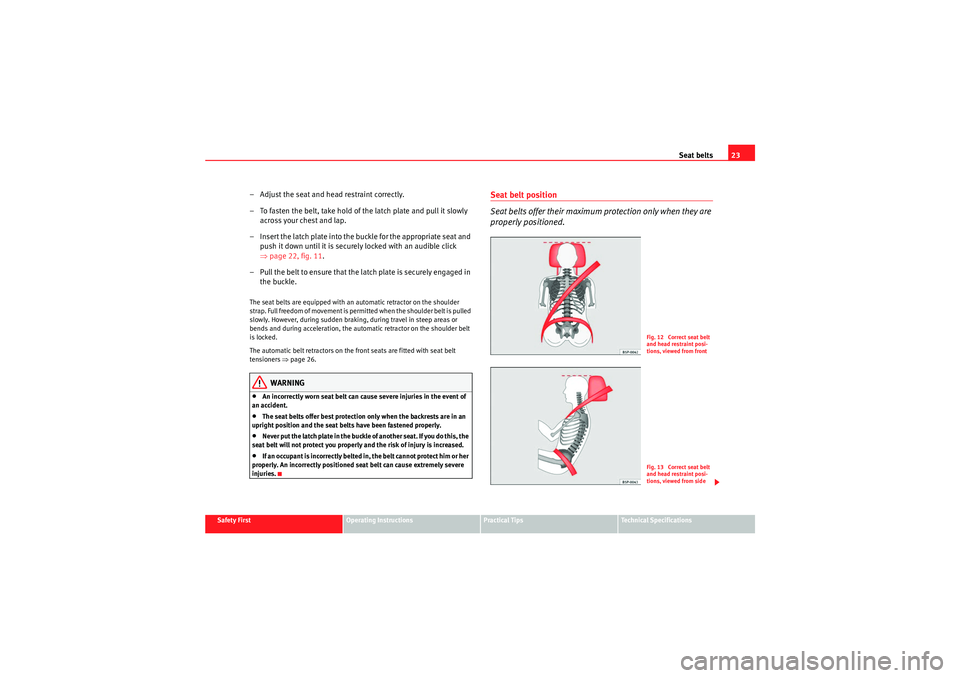
Seat belts23
Safety First
Operating Instructions
Practical Tips
Technical Specifications
– Adjust the seat and head restraint correctly.
– To fasten the belt, take hold of the latch plate and pull it slowly
across your chest and lap.
– Insert the latch plate into the buckle for the appropriate seat and push it down until it is securely locked with an audible click
⇒page 22, fig. 11 .
– Pull the belt to ensure that the latch plate is securely engaged in the buckle.The seat belts are equipped with an automatic retractor on the shoulder
strap. Full freedom of movement is permitted when the shoulder belt is pulled
slowly. However, during sudden braking, during travel in steep areas or
bends and during acceleration, the automatic retractor on the shoulder belt
is locked.
The automatic belt retractors on the front seats are fitted with seat belt
tensioners ⇒page 26.
WARNING
•An incorrectly worn seat belt can cause severe injuries in the event of
an accident.•The seat belts offer best protection only when the backrests are in an
upright position and the seat belts have been fastened properly.•Never put the latch plate in the buckle of another seat. If you do this, the
seat belt will not protect you properly and the risk of injury is increased.•I f a n o ccu p an t is i n co r re c t l y be l te d i n , t h e b e l t ca n n o t p ro te c t h i m o r h e r
properly. An incorrectly positioned seat belt can cause extremely severe
injuries.
Seat belt position
Seat belts offer their maximum protection only when they are
properly positioned.
Fig. 12 Correct seat belt
and head restraint posi-
tions, viewed from frontFig. 13 Correct seat belt
and head restraint posi-
tions, viewed from side
IbizaST_EN.book Seite 23 Dienstag, 14. September 2010 1:31 13
Page 27 of 264
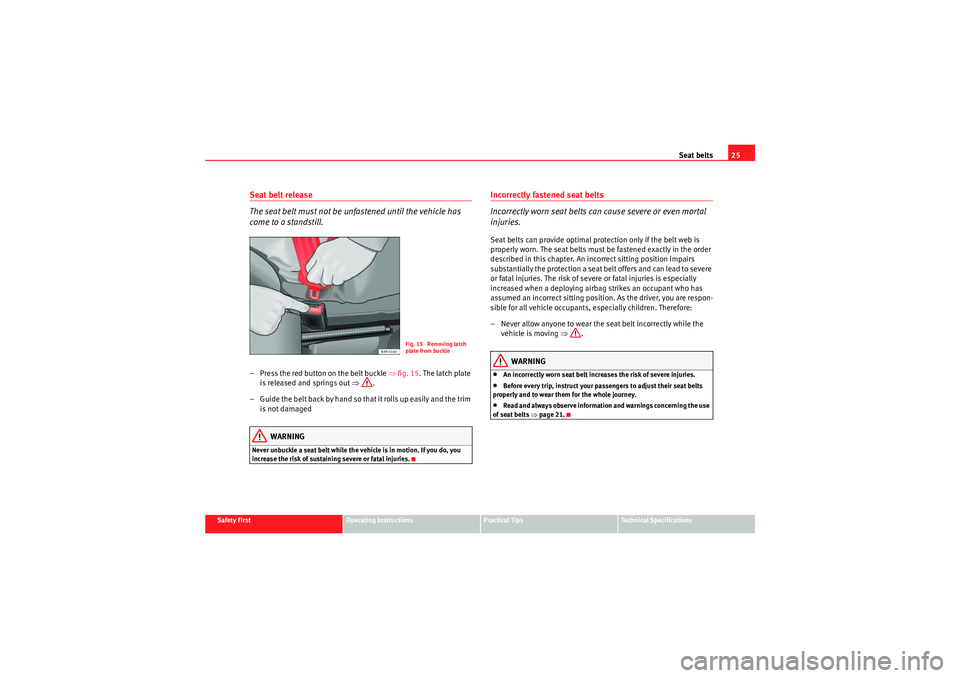
Seat belts25
Safety First
Operating Instructions
Practical Tips
Technical Specifications
Seat belt release
The seat belt must not be unfastened until the vehicle has
come to a standstill.– Press the red button on the belt buckle ⇒fig. 15 . The latch plate
is released and springs out ⇒ .
– Guide the belt back by hand so that it rolls up easily and the trim is not damaged
WARNING
Never unbuckle a seat belt while the vehicle is in motion. If you do, you
increase the risk of sustaining severe or fatal injuries.
Incorrectly fastened seat belts
Incorrectly worn seat belts can cause severe or even mortal
injuries.Seat belts can provide optimal protection only if the belt web is
properly worn. The seat belts must be fastened exactly in the order
described in this chapter. An incorrect sitting position impairs
substantially the protection a seat belt offers and can lead to severe
or fatal injuries. The risk of severe or fatal injuries is especially
increased when a deploying airbag strikes an occupant who has
assumed an incorrect sitting position. As the driver, you are respon-
sible for all vehicle occupants, especially children. Therefore:
– Never allow anyone to wear the seat belt incorrectly while the vehicle is moving ⇒.
WARNING
•An incorrectly worn seat belt increases the risk of severe injuries.•Before every trip, instruct your passengers to adjust their seat belts
properly and to wear them for the whole journey.•Read and always observe information and warnings concerning the use
of seat belts ⇒page 21.
Fig. 15 Removing latch
plate from buckle
IbizaST_EN.book Seite 25 Dienstag, 14. September 2010 1:31 13
Page 29 of 264

Airbag system27
Safety First
Operating Instructions
Practical Tips
Technical Specifications
Airbag systemBrief introductionWhy wear a seat belt and assume the correct sitting position?
For the inflating airbags to achieve the best protection, the
seat belt must always be worn properly and the correct sitting
position must be assumed.For your own safety and the safety of the passengers, please ensure
the following before driving:
– Always wear the seat belt properly
– Adjust the driver seat and the steering wheel correctly.
– Adjust the front passenger seat correctly.
– Adjust the head restraint correctly ⇒page 12.
– Use an appropriate child restrain t system to protect children in
your vehicle.The airbag is deployed at high speed in fractions of a second. If you have an
incorrect seating position at the time the airbag is deployed, it could cause
you critical injuries. Therefore, it is essential that all passengers in the vehicle
assume a correct sitting position while travelling.
A sharp braking before an accident may cause a passenger not wearing a seat
belt to be thrown forward into the area of the deploying airbag. In this case, the inflating airbag may inflict critical or fatal injuries on the occupant. This
also applies to children.
Always maintain the greatest possible distance between yourself and the
front airbag. This way, the front airbags can completely deploy when trig-
gered, providing their maximum protection.
The most important factors that will trigger an airbag are: the type of acci-
dent, the angle of collision and the speed of the vehicle.
Whether the airbags are triggered depends primarily on the vehicle deceler-
ation rate resulting from the collision and detected by the control unit. If the
vehicle deceleration occurring during the collision and measured by the
control unit remains below the specified reference values, the front, side
and/or curtain airbag will not be triggered. Take into account that the visible
damage in a vehicle involved in an accident, no matter how serious, is not a
determining factor for the airbags to have been triggered.
WARNING
•Wearing the seat belt incorrectly or assuming an incorrect sitting posi-
tion can lead to critical or fatal injuries.•All occupants, including children, who are not properly belted can
sustain critical or fatal injuries if the airbag is triggered. Children up to 12
years old should always travel on the rear seat. Never transport children in
the vehicle if they are not restrained or the restraint system is not appro-
priate for their age, size or weight.•If you are not wearing a seat belt, if you lean forward or to the side while
travelling or assume an incorrect sitting position, there is a substantially
increased risk of injury. This increased risk of injury will be further
increased if you are struck by an inflating airbag.•To reduce the risk of injury from an inflating airbag, always wear the
seat belt properly.
IbizaST_EN.book Seite 27 Dienstag, 14. September 2010 1:31 13
Page 31 of 264
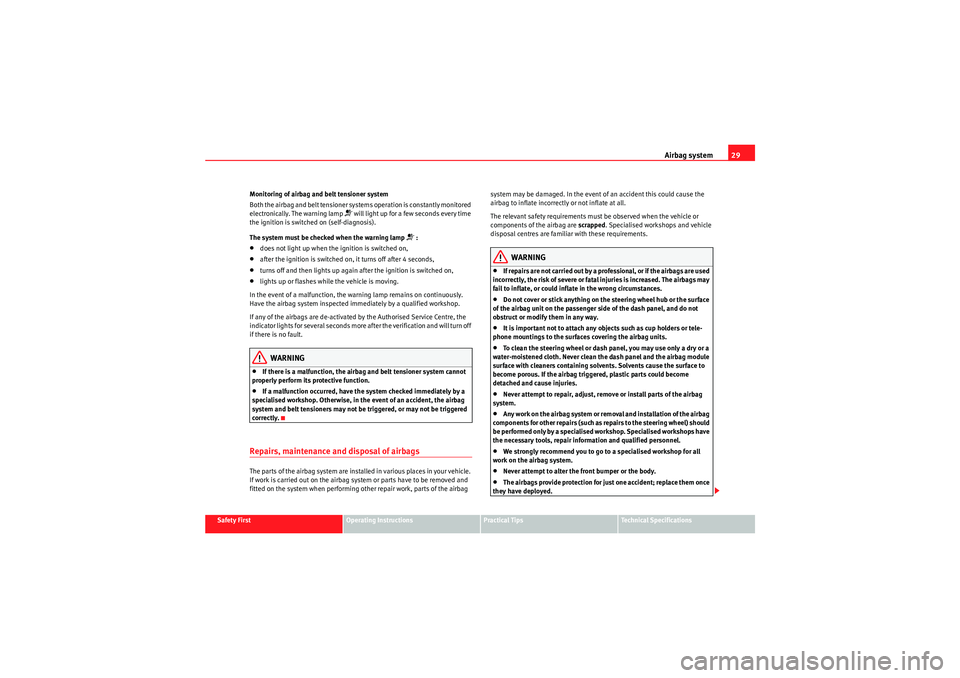
Airbag system29
Safety First
Operating Instructions
Practical Tips
Technical Specifications
Monitoring of airbag and belt tensioner system
Both the airbag and belt tensioner systems operation is constantly monitored
electronically. The warning lamp
�T will light up for a few seconds every time
the ignition is switched on (self-diagnosis).
The system must be checked when the warning lamp
�T :
•does not light up when the ignition is switched on,•after the ignition is switched on, it turns off after 4 seconds,•turns off and then lights up again after the ignition is switched on,•lights up or flashes while the vehicle is moving.
In the event of a malfunction, the warning lamp remains on continuously.
Have the airbag system inspected immediately by a qualified workshop.
If any of the airbags are de-activated by the Authorised Service Centre, the
indicator lights for several seconds more after the verification and will turn off
if there is no fault.WARNING
•If there is a malfunction, the airbag and belt tensioner system cannot
properly perform its protective function.•If a malfunction occurred, have the system checked immediately by a
specialised workshop. Otherwise, in the event of an accident, the airbag
system and belt tensioners may not be triggered, or may not be triggered
correctly.
Repairs, maintenance and disposal of airbagsThe parts of the airbag system are instal led in various places in your vehicle.
If work is carried out on the airbag system or parts have to be removed and
fitted on the system when performing other repair work, parts of the airbag system may be damaged. In the event of an accident this could cause the
airbag to inflate incorrectly or not inflate at all.
The relevant safety requirements must be observed when the vehicle or
components of the airbag are
scrapped. Specialised workshops and vehicle
disposal centres are familiar with these requirements.
WARNING
•If repairs are not carried out by a professional, or if the airbags are used
incorrect ly, th e ris k of se vere or fatal inj uries is increas ed. T he airbags may
fail to inflate, or could inflate in the wrong circumstances.•Do not cover or stick anything on the steering wheel hub or the surface
of the airbag unit on the passenger side of the dash panel, and do not
obstruct or modify them in any way.•It is important not to attach any objects such as cup holders or tele-
phone mountings to the surfaces covering the airbag units.•To clean the steering wheel or dash panel, you may use only a dry or a
water-moistened cloth. Never clean the dash panel and the airbag module
surface with cleaners containing solvents. Solvents cause the surface to
become porous. If the airbag triggered, plastic parts could become
detached and cause injuries.•Never attempt to repair, adjust, remove or install parts of the airbag
system.•Any work on the airbag system or removal and installation of the airbag
components for other repairs (such as repairs to the steering wheel) should
be performed only by a specialised workshop. Specialised workshops have
the necessary tools, repair information and qualified personnel.•We strongly recommend you to go to a specialised workshop for all
work on the airbag system.•Never attempt to alter the front bumper or the body.•The airbags provide protection for just one accident; replace them once
they have deployed.
IbizaST_EN.book Seite 29 Dienstag, 14. September 2010 1:31 13
Page 33 of 264
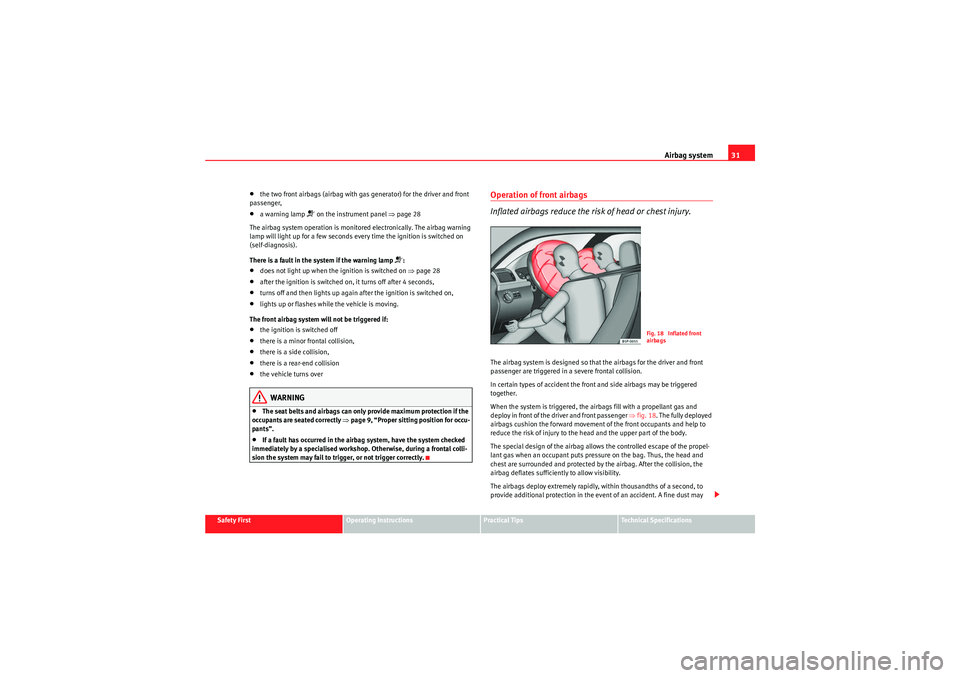
Airbag system31
Safety First
Operating Instructions
Practical Tips
Technical Specifications
•the two front airbags (airbag with gas generator) for the driver and front
passenger,•a warning lamp
�T on the instrument panel ⇒page 28
The airbag system operation is monitored electronically. The airbag warning
lamp will light up for a few seconds every time the ignition is switched on
(self-diagnosis).
There is a fault in the system if the warning lamp
�T:
•does not light up when the ignition is switched on ⇒ page 28•after the ignition is switched on, it turns off after 4 seconds,•turns off and then lights up again after the ignition is switched on,•lights up or flashes while the vehicle is moving.
The front airbag system will not be triggered if:•the ignition is switched off•there is a minor frontal collision,•there is a side collision,•there is a rear-end collision•the vehicle turns overWARNING
•The seat belts and airbags can only provide maximum protection if the
occupants are seated correctly ⇒ page 9, “Proper sitting position for occu-
pants”.•If a fault has occurred in the airbag system, have the system checked
immediately by a specialised workshop. Otherwise, during a frontal colli-
sion the system may fail to trigger, or not trigger correctly.
Operation of front airbags
Inflated airbags reduce the risk of head or chest injury.The airbag system is designed so that the airbags for the driver and front
passenger are triggered in a severe frontal collision.
In certain types of accident the front and side airbags may be triggered
together.
When the system is triggered, the airbags fill with a propellant gas and
deploy in front of the driver and front passenger ⇒ fig. 18. The fully deployed
airbags cushion the forward movement of the front occupants and help to
reduce the risk of injury to the head and the upper part of the body.
The special design of the airbag allows the controlled escape of the propel-
lant gas when an occupant puts pressure on the bag. Thus, the head and
chest are surrounded and protected by the airbag. After the collision, the
airbag deflates sufficiently to allow visibility.
The airbags deploy extremely rapidly, within thousandths of a second, to
provide additional protection in the event of an accident. A fine dust may
Fig. 18 Inflated front
airbags
IbizaST_EN.book Seite 31 Dienstag, 14. September 2010 1:31 13
Page 35 of 264
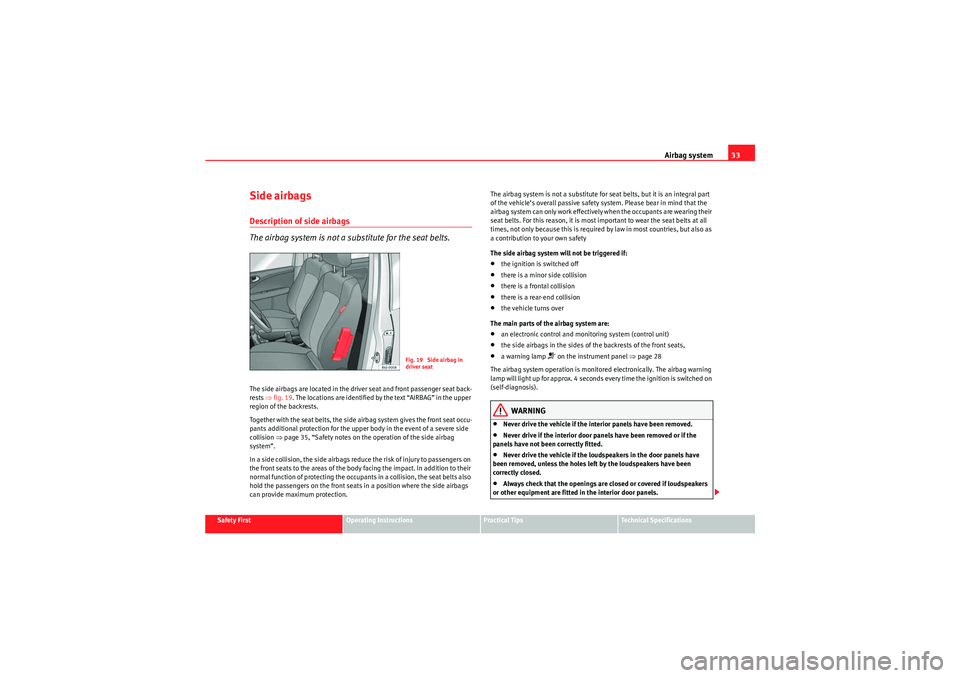
Airbag system33
Safety First
Operating Instructions
Practical Tips
Technical Specifications
Side airbagsDescription of side airbags
The airbag system is not a substitute for the seat belts.The side airbags are located in the driver seat and front passenger seat back-
rests ⇒fig. 19 . The locations are identified by the text “AIRBAG” in the upper
region of the backrests.
Together with the seat belts, the side airbag system gives the front seat occu-
pants additional protection for the upper body in the event of a severe side
collision ⇒page 35, “Safety notes on the operation of the side airbag
system”.
In a side collision, the side airbags reduce the risk of injury to passengers on
the front seats to the areas of the body facing the impact. In addition to their
normal function of protecting the occupants in a collision, the seat belts also
hold the passengers on the front seats in a position where the side airbags
can provide maximum protection. The airbag system is not a substitute for seat belts, but it is an integral part
of the vehicle’s overall passive safety system. Please bear in mind that the
airbag system can only work effectively when the occupants are wearing their
seat belts. For this reason, it is most important to wear the seat belts at all
times, not only because this is required by law in most countries, but also as
a contribution to your own safety
The side airbag system will not be triggered if:
•the ignition is switched off•there is a minor side collision•there is a frontal collision•there is a rear-end collision•the vehicle turns over
The main parts of the airbag system are:•an electronic control and monitoring system (control unit)•the side airbags in the sides of the backrests of the front seats,•a warning lamp
�T on the instrument panel ⇒page 28
The airbag system operation is monitored electronically. The airbag warning
lamp will light up for approx. 4 seconds every time the ignition is switched on
(self-diagnosis).
WARNING
•Never drive the vehicle if the interior panels have been removed.•Never drive if the interior door panels have been removed or if the
panels have not been correctly fitted.•Never drive the vehicle if the loudspeakers in the door panels have
been removed, unless the holes left by the loudspeakers have been
correctly closed.•Always check that the openings are closed or covered if loudspeakers
or other equipment are fitted in the interior door panels.
Fig. 19 Side airbag in
driver seat
IbizaST_EN.book Seite 33 Dienstag, 14. September 2010 1:31 13
Page 37 of 264
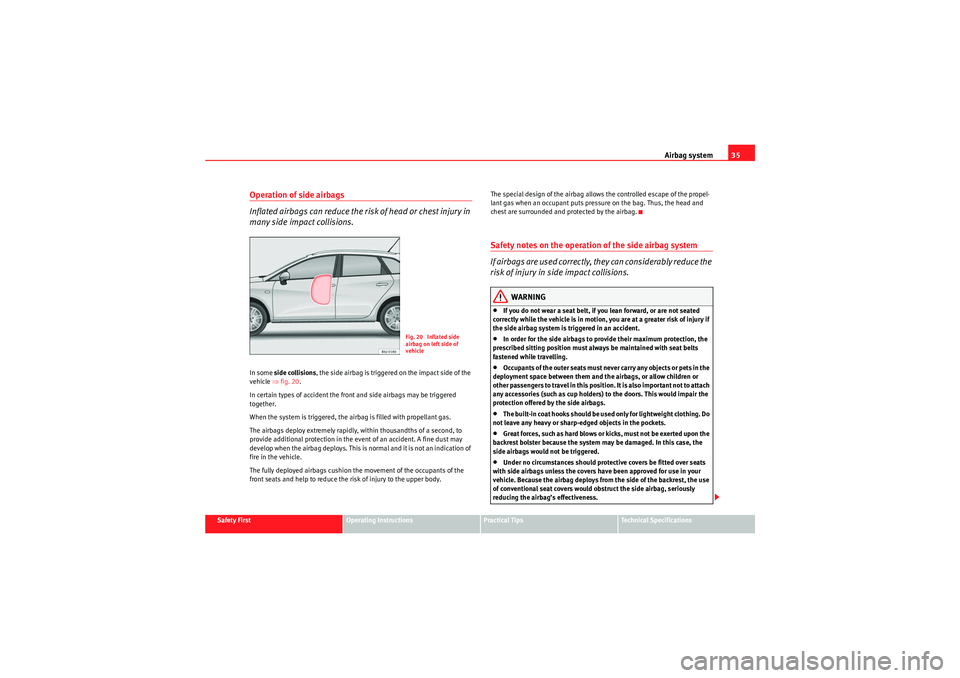
Airbag system35
Safety First
Operating Instructions
Practical Tips
Technical Specifications
Operation of side airbags
Inflated airbags can reduce the risk of head or chest injury in
many side impact collisions.In some side collisions , the side airbag is triggered on the impact side of the
vehicle ⇒fig. 20 .
In certain types of accident the front and side airbags may be triggered
together.
When the system is triggered, the airbag is filled with propellant gas.
The airbags deploy extremely rapidly, within thousandths of a second, to
provide additional protection in the event of an accident. A fine dust may
develop when the airbag deploys. This is normal and it is not an indication of
fire in the vehicle.
The fully deployed airbags cushion the movement of the occupants of the
front seats and help to reduce the risk of injury to the upper body. The special design of the airbag allows the controlled escape of the propel-
lant gas when an occupant puts pressure on the bag. Thus, the head and
chest are surrounded and protected by the airbag.
Safety notes on the operation of the side airbag system
If airbags are used correctly, they can considerably reduce the
risk of injury in side impact collisions.
WARNING
•If you do not wear a seat belt, if you lean forward, or are not seated
correctly while the vehicle is in motion, you are at a greater risk of injury if
the side airbag system is triggered in an accident.•In order for the side airbags to provide their maximum protection, the
prescribed sitting position must always be maintained with seat belts
fastened while travelling.•Occupants of the outer seats must never carry any objects or pets in the
deployment space between them and the airbags, or allow children or
other passengers to travel in this position. It is also important not to attach
any accessories (such as cup holders) to the doors. This would impair the
protection offered by the side airbags.•The built-in coat hooks should be used only for lightweight clothing. Do
not leave any heavy or sharp-edged objects in the pockets.•Great forces, such as hard blows or kicks, must not be exerted upon the
backrest bolster because the system may be damaged. In this case, the
side airbags would not be triggered.•Under no circumstances should protective covers be fitted over seats
with side airbags unless the covers have been approved for use in your
vehicle. Because the airbag deploys from the side of the backrest, the use
of conventional seat covers would obstruct the side airbag, seriously
reducing the airbag’s effectiveness.
Fig. 20 Inflated side
airbag on left side of
vehicle
IbizaST_EN.book Seite 35 Dienstag, 14. September 2010 1:31 13
Page 39 of 264

Airbag system37
Safety First
Operating Instructions
Practical Tips
Technical Specifications
Deactivating airbags*Front passenger airbag deactivation
If you fit a rear-facing child seat to the front passenger seat,
the front passenger airbag must be de-activated.
When the passenger airbag is deactivated, this means that only the
passenger front airbag is deactiva ted. All the other airbags in the
vehicle remain activated.
Deactivating the front passenger airbag
– Switch the ignition off.
– Turn the ignition switch in the key operated switch in the glove
compartment to the position OFF ⇒ fig. 21 .
– Check that the warning lamp “AIRBAG OFF” on the dash panel ⇒fig. 22 remains lit ⇒ when the ignition is switched on.
Activating the front passenger airbag
– Switch the ignition off.
– Turn the ignition key in the key-operated switch in the glove compartment to the position ON ⇒ fig. 21 .
Fig. 21 In the glove
compartment: switch for
activating and deacti-
vating the front passenger
airbag
Fig. 22 Warning lamp for
deactivated passenger
airbag in centre console
IbizaST_EN.book Seite 37 Dienstag, 14. September 2010 1:31 13
Page 41 of 264

Child safety39
Safety First
Operating Instructions
Practical Tips
Technical Specifications
Child safetyBrief introductionIntroduction
Statistics show that children are generally safer on the rear
seat than on the front passenger seat.For safety reasons we recommend that children under 12 years of age travel
on the rear seats. Depending on their age, height and weight, children trav-
elling on the rear seat must use a child seat or a seat belt. For safety reasons,
the child seat should be installed in the centre of the rear seat or behind the
front passenger seat.
The physical laws involved and the forces acting in a collision apply also to
children. ⇒page 19, “Why wear seat belts?”. But unlike adults, children do
not have muscle and bone structures fully developed. This means that chil-
dren are subject to a greater risk of injury.
To reduce this risk, children must always use special child restraint systems
when travelling in the vehicle.
We re co m m en d t he use o f child saf et y p rod uc ts fr om t he SE AT Ge nu ine Acces -
sories Programme, which includes systems for all ages made by “Peke”
2).
These systems have been especially designed and approved, complying with
the ECE-R44. regulation.
Follow the manufacturer’s instructions and observe any statutory require-
ments when installing and using child seats. Always read and note
⇒ page 39, “Safety notes on using child seats”. We recommend you to include the manufacturer’s Child Seat instruction
manual together with the on-board documentation.
Safety notes on using child seats
Proper use of child seats substantially reduces the risk of
injury in an accident!As the driver, you are responsible for any children you transport in
your vehicle.
– Protect your children by properly using the appropriate child
seats ⇒page 41.
– Always ensure that the seat belt is properly positioned according
to the instructions provided by the manufacturer of the child
seat.
– When travelling, do not allow children to distract you from traffic.
– Take breaks regularly during long trips. Take a break at least
every two hours.
WARNING
•Never install a child seat facing backwards on the front passenger seat
unless the front passenger airbag has been disabled. This could lead to a
risk of potentially fatal injuries to the child! However, if it is necessary, in
exceptional cases, to transport a child in the front passenger seat, the front
passenger airbag must always be disabled ⇒page 37, “Deactivating
2)Not for all countries
IbizaST_EN.book Seite 39 Dienstag, 14. September 2010 1:31 13
Page 43 of 264
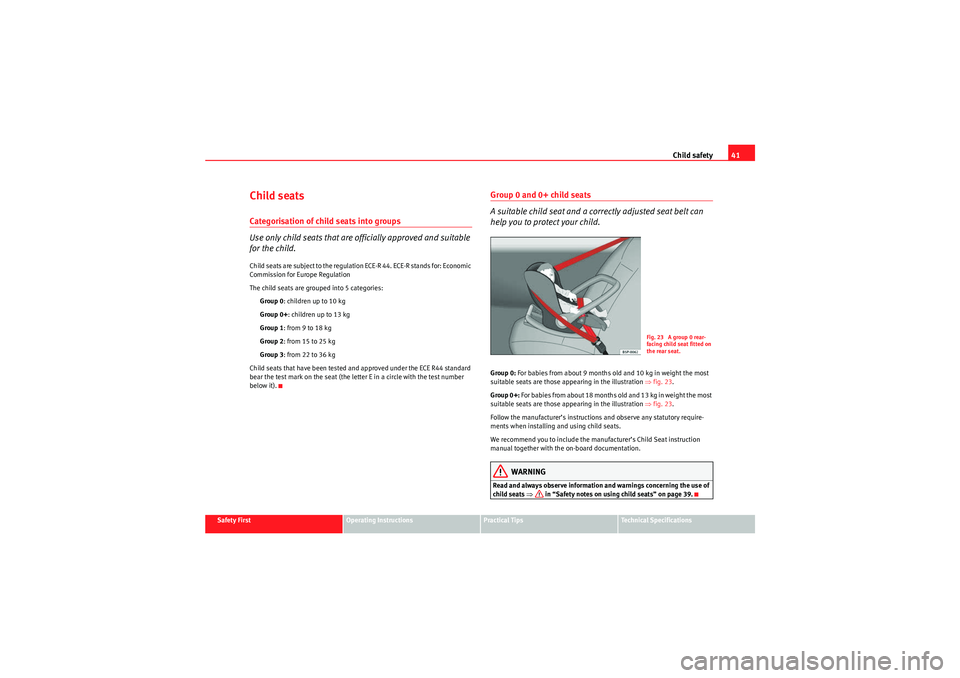
Child safety41
Safety First
Operating Instructions
Practical Tips
Technical Specifications
Child seatsCategorisation of child seats into groups
Use only child seats that are officially approved and suitable
for the child.Child seats are subject to the regulation ECE-R 44. ECE-R stands for: Economic
Commission for Europe Regulation
The child seats are grouped into 5 categories:
Group 0 : children up to 10 kg
Group 0+ : children up to 13 kg
Group 1 : from 9 to 18 kg
Group 2 : from 15 to 25 kg
Group 3 : from 22 to 36 kg
Child seats that have been tested and approved under the ECE R44 standard
bear the test mark on the seat (the letter E in a circle with the test number
below it).
Group 0 and 0+ child seats
A suitable child seat and a correctly adjusted seat belt can
help you to protect your child.Group 0: For babies from about 9 months old and 10 kg in weight the most
suitable seats are those appearing in the illustration ⇒fig. 23 .
Group 0+: For b ab ies f ro m ab o ut 18 m o nth s old a nd 1 3 kg in wei ght th e m ost
suitable seats are those appearing in the illustration ⇒fig. 23 .
Follow the manufacturer’s instructions and observe any statutory require-
ments when installing and using child seats.
We recommend you to include the manufacturer’s Child Seat instruction
manual together with the on-board documentation.
WARNING
Read and always observe information and warnings concerning the use of
child seats ⇒ in “Safety notes on using child seats” on page 39.
Fig. 23 A group 0 rear-
facing child seat fitted on
the rear seat.
IbizaST_EN.book Seite 41 Dienstag, 14. September 2010 1:31 13